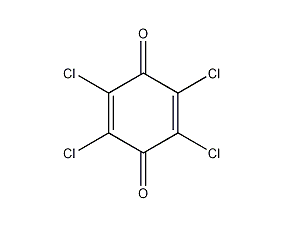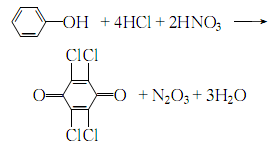
Structural formula
| Business number | 03A3 |
|---|---|
| Molecular formula | C6Cl4O2 |
| Molecular weight | 245.87 |
| label |
Chloroquinone, tetrachloroquinone, Coversan,Reranil,Tetrachloroquinone,VulklorSpergon, Fungicide |
Numbering system
CAS number:118-75-2
MDL number:MFCD00001594
EINECS number:204-274-4
RTECS number:None
BRN number:393006
PubChem number:DK6825000
Physical property data
1. Properties: golden leaf-like crystals or yellow crystal powder.
2. Density (g/mL, 25℃): 1.97
3. Gas phase standard claims heat (enthalpy) (kJ·mol-1) : -185.7
4. Melting point (ºC): 290
5. Liquid phase standard claims heat (enthalpy) (kJ·mol-1): -158.0
6. Boiling point (ºC, kPa): Not determined
7. Refractive index: Not determined
8. Flash point (ºC): Not determined Determined
9. Specific rotation (º): Undetermined
10. Autoignition point or ignition temperature (ºC): Undetermined
11. Vapor Pressure (mmHg, 25ºC): Undetermined
12. Saturated vapor pressure (kPa, ºC): Undetermined
13. Heat of combustion (KJ/mol): Undetermined
p>
14. Critical temperature (ºC): Undetermined
15. Critical pressure (KPa): Undetermined
16. Oil-water (octanol/water) partition coefficient Logarithmic value of p>
19. Solubility: Soluble in sodium hydroxide solution and ether, slightly soluble in alcohol, insoluble in chloroform, carbon tetrachloride and carbon disulfide, almost insoluble in cold alcohol and insoluble in water.
Toxicological data
1. Acute toxicity: Oral LD50 in rats: 4000mg/kg
Inhalation LD50 in rats: 2485mg/m3/4H
Ecological data
Hazardous to water.
Molecular structure data
1. Molar refractive index: 46.25
2. Molar volume (cm3/mol): 136.0
3. Isotonic specific volume (90.2K): 367.0
4. Surface tension (dyne/cm): 52.9
5. Polarizability (10-24cm3���:18.33
Compute chemical data
1. Reference value for hydrophobic parameter calculation (XlogP): 3.4
2. Number of hydrogen bond donors: 0
3. Number of hydrogen bond acceptors: 2
4. Number of rotatable chemical bonds: 0
5. Number of tautomers: none
6. Topological molecule polar surface area 34.1
7. Number of heavy atoms: 12
8. Surface charge: 0
9. Complexity: 278
10. Number of isotope atoms: 0
11. Determine the number of atomic stereocenters: 0
12. Uncertain number of atomic stereocenters: 0
13. Determine the number of chemical bond stereocenters: 0
14. Number of uncertain chemical bond stereocenters: 0
15. Number of covalent bond units: 1
Properties and stability
Avoid contact with oxides. Non-toxic, sublimation phenomenon occurs. Stable in acidic media, will decompose in alkaline media.
Storage method
1. Store sealed in a cool, dry place. Make sure the workspace has good ventilation.
2. Store away from oxidants. Good storage stability, avoid contact with alkaline substances.
Synthesis method
1. Obtained from the oxidation of pentachlorophenol. Add 20% sodium pentachlorophenol solution into the reaction kettle, acidify with equimolar 35% hydrochloric acid, and stir into a paste. Then add anhydrous ferric chloride at 6% of the weight of sodium pentachlorophenate, raise the temperature to above 70°C, start passing chlorine, and keep the reaction temperature above 95°C until the reaction oil is completely clear and particle-free. Separate the water layer, remove the homogeneous substance and add 98% concentrated sulfuric acid to acidify it to obtain tetrachlorobenzoquinone.



2.Add phenol to aqua regia,Stir for 10 minutes and then heat up. The reactant will change from black oil to dark red to red flake crystals, about 20 to 24 hours, cool, filter out the crystals, soak in alcohol repeatedly, and filter until the flake crystals turn golden yellow. After drying, the finished product is obtained.
The reaction formula is:

Purpose
1. This product is used as a vulcanizing agent for natural rubber, butyl synthetic rubber, nitrile rubber and chloroprene rubber.
2. Mainly used in the manufacture of butyl rubber inner tubes, outer tires, vulcanization bladders, heat-resistant products, insulated wires, etc. It can be used alone or mixed with sulfur and other vulcanization accelerators (usually with accelerator DM) to make cables and sponge rubber products, with a dosage of 0.5% to 4.0%. For example, adding 5% to 20% can improve the bonding strength between the rubber and the fabric material.
3. This product is used to manufacture anti-tumor drugs iminoquinone and cancer inhibitor powder, and the diuretic spironistol; it is also used as dye intermediates and agricultural seed dressing agents.
4.Used as oxidant and pesticide. Used in tetrachloroquinone electrode manufacturing and organic synthesis.
5.Used as a chromogenic reagent for the photometric determination of isoniazid. It is also used in organic synthesis and preparation of tetrachloroquinone electrodes.

 微信扫一扫打赏
微信扫一扫打赏

